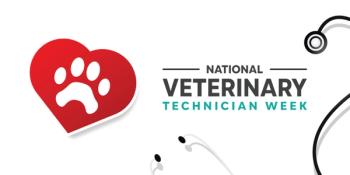
- dvm360 July 2024
- Volume 55
- Issue 7
Communicating value for technician appointment fees
Scripts for confident client conversations include identifying the reason for the patient’s visit
Q: Our hospital started charging for technician appointments after listening to your advice as a guest on dvm360’s
A: A Credentialed technicians and veterinary assistants bring valuable medical skills, nursing care, and client education that merits fees. As I discussed o
A health assessment includes getting patients’ vital signs, asking history questions, and updating medical records. Decide which services need health assessments for technician appointments. For example, perform a health assessment on patients to change bandages, clean ears, express anal glands, administer subcutaneous fluids, give booster vaccines, and other services where a health assessment is medically necessary. A health assessment may not be medically necessary to trim nails or collect samples for diagnostic tests
To communicate value for the health assessment fee, technicians and assistants should introduce themselves at the beginning of technician appointments and explain they will perform a health assessment with today’s services. Say this: “Hello, . I am , a licensed veterinary technician who will change your dog’s bandage today. I also will perform a health assessment to confirm that ’s wound is properly healing. This health assessment will include getting your pet’s vital signs of temperature, pulse, respiration, and weight; asking you questions about home care; and updating your pet’s medical record. What questions may I answer before we get started?”
If a patient has a technician appointment for a booster vaccine, the technician or assistant should explain, “I’m , the veterinary assistant who will perform ’s health assessment and give the Leptospirosis booster vaccine. I will get ’s vital signs, including temperature, pulse, respiration, and weight. I will ask questions about your pet’s health and update ’s medical record with the vital signs and information we discuss. What questions may I answer before we get started?”
If clients check out at the front desk, client service representatives (CSRs) should summarize services before sharing the total. Restating services reinforces the care your team provided and creates the perception of value. Say this: “ received a health assessment and bandage change today from our licensed veterinary technician, . Your total is $____. Which payment method do you prefer to use?”
List employees’ names on receipts. Just as you list the doctor’s name on client receipts, include the name of the technician or assistant who delivered care on the invoice. This creates value for professional fees and personalizes the visit because pet owners know exactly who provided care. Use staff ID codes in your practice management software that have an invoice item description. For example, a client’s receipt would note, “Your licensed veterinary technician today was Amy.” If clients have follow-up questions after technician appointments, they can request the technician or assistant listed on the invoice.
Identify the right reason for a visit
Q: Clients schedule checkups and then blindside doctors with, “Oh, yeah… could you also check?” at the end of appointments. When scheduling appointments, what should our CSRs say to ensure patients with health concerns aren’t booked in checkup slots?
A: Your team can take 3 steps to make sure you have the right reason for the visit:
Ask about health or behavior concerns during scheduling calls.
When clients call to book checkups, a CSR should review the electronic medical record to confirm which services are due. The CSR should say, “ is due for an exam, vaccines, diagnostic tests, and preventative refills. Does have any health or behavior concerns that you want to discuss with the doctor?” This probing question leads clients to share health concerns or additional services upfront, which may shift the appointment from a preventive visit to a sick patient exam. Many well pets may have sick pet problems, such as ear infections, skin issues, lumps, and bumps.
Send confirmations with links to online forms.
After clients book appointments, immediately send confirmations with a link to the corresponding online history form based on appointment type. If clients schedule checkups, they get a wellness history form. If they book sick patient exams, clients get a medical concern history form. Send a series of 4 confirmations as follows:
- Immediately upon booking
- 2 weeks prior
- 4 days prior
- 2 days prior
Require clients to submit completed history forms 2 days before appointments. Let’s say your CSR skims the completed wellness history form. The client checked the box for urination issues. Your CSR will call the client to get more details that may lead to changing the appointment type from a preventive visit to a sick patient exam.
Have technicians or assistants ask about health or behavior concerns at the start of appointments
Say this: “Hi, . I am , the licensed veterinary technician who will help Dr with today’s checkup for . Thanks for submitting the wellness history form in advance, which I have read, and I will ask you a few follow-up questions. Does your pet have any health or behavior concerns that you want to discuss with the doctor today?” If the client shares information on urination issues, this becomes the chief complaint. The technician can get the patient’s vital signs and ask follow-up questions to the client’s answers on the online form. The technician will alert the veterinarian of the new chief complaint before he or she enters the exam room. This allows the doctor to prioritize the order of services and better manage exam time.
Articles in this issue
about 1 year ago
Incentivizing retentionabout 1 year ago
Finding relief in relief medicineabout 1 year ago
New questionnaire aims to help identify equine osteoarthritisabout 1 year ago
The numbers game can add up to a winning strategy for practicesabout 1 year ago
How to support higher pay raisesabout 1 year ago
Smart ways to handle too much businessover 1 year ago
Experience dvm360’s must-see Fetch Coastal sessionsover 1 year ago
Grab the poop bags and goover 1 year ago
Temporomandibular joint prosthesis for cats and dogsNewsletter
From exam room tips to practice management insights, get trusted veterinary news delivered straight to your inbox—subscribe to dvm360.






